
Base MSRP: $24,200
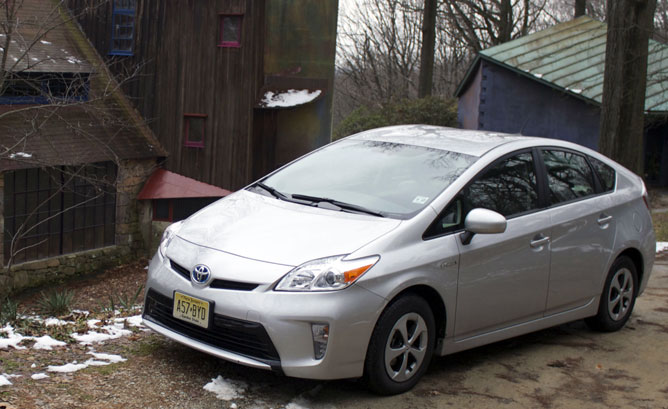
As the North American sales leader among all alternative energy cars, the 2013 Prius Liftback is reasonably fresh from 2011 styling updates and a complete 2010 overhaul. So perhaps Toyota figured it didn’t need to mess with success in carrying it forward unchanged from the 2012 model year.
The Prius has been called the “Liftback” for a year now to distinguish it from three new Prii offshoots. 2012 saw the launch of the smaller Prius c hatchback, the Liftback-based Prius Plug-in Hybrid Electric Vehicle, and the late-2011-released Prius v wagon settled into its stride as well.
The Liftback is a third-generation rendition of a car that was first launched in Japan in 1997 and to the U.S. in 2000. It has paid dues to become the vehicle many people think of when they hear the term “hybrid car.”
Toyota has considered making the Prius its own unique sub-brand, and in a sense it is regardless. Company officials have said the car is a Prius first, and a Toyota second. This year, U.S. Liftback sales are up nearly 20 percent – triple the next-nearest competitor, another Toyota, the Camry Hybrid and quadruple the still-getting-started but otherwise well-ranked Prius v and Prius c.
For all the talk over the years of the Prius being an “icon” of the green car movement, it is dangerously close to morphing into mainstream status. To be sure, it does remain unique and still prompts polarized reactions for some between love and hate. And if you’re one of the many in love with its exclusive identity, have at it, but between the opposite poles are a growing number of owners who merely see the Prius as a serviceable five-passenger family hatchback.
Blame – or credit – the blurring of the previously sharper lines of demarcation on its success. Its broaching into ordinary status is due in part to the Prius’ solid reliability record, and it’s hard to argue with its EPA-rated 50 mpg combined, 51 mpg city, 48 mpg highway.
For 2013, the Liftback continues with four trim levels – Two, Three, Four and Five – with trim level One available only to fleets. New this year is a Persona Series Special Edition. The Persona trim package is a styling exercise priced between levels Three and Four. It features unique exterior colors, interior design, and 17-inch cast alloy wheels – larger than the 15-inchers on all Liftbacks except level Five which also comes with 17-inch wheels.
At the heart of the Liftback is a 1.8-liter Atkinson-cycle four-cylinder engine plus electric motor, and nickel-metal hydride battery. This propulsion energy is channeled to the front wheels by a continuously variable transmission (CVT) that acts like an automatic. The gasoline engine delivers 98 horsepower at 5,200 rpm. The electric motor kicks in 80 additional horsepower but because the two forms of motive power deliver their maximum output at different points, peak horsepower is stated at 134.
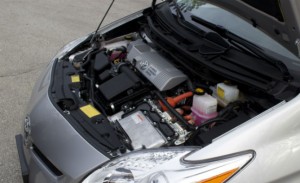 Unlike the new breed of plug-in cars – such as the Prius PHEV, Ford C-MAX Energi, Fusion Energi, and Chevy Volt – the Prius Liftback can deliver its peak mpg and lowest emissions from start to finish of a tank of gas. Its battery is recharged by the engine and regenerative braking so it won’t run out of juice as with a plug-in powertrain. Some have touted the fact that it “does not need to be plugged in” as a benefit, but we’d characterize it as a trade-off. One could just as well say a plug-in hybrid “can be conveniently charged at home,” and on shorter commutes it “may not often have to stop at a gas station.” But in the plug-less Liftback’s favor, it follows a familiar formula using traditional refueling infrastructure to deliver predictably high economy, costs less on the sticker, and is easier for average consumers to wrap their minds around.
Unlike the new breed of plug-in cars – such as the Prius PHEV, Ford C-MAX Energi, Fusion Energi, and Chevy Volt – the Prius Liftback can deliver its peak mpg and lowest emissions from start to finish of a tank of gas. Its battery is recharged by the engine and regenerative braking so it won’t run out of juice as with a plug-in powertrain. Some have touted the fact that it “does not need to be plugged in” as a benefit, but we’d characterize it as a trade-off. One could just as well say a plug-in hybrid “can be conveniently charged at home,” and on shorter commutes it “may not often have to stop at a gas station.” But in the plug-less Liftback’s favor, it follows a familiar formula using traditional refueling infrastructure to deliver predictably high economy, costs less on the sticker, and is easier for average consumers to wrap their minds around.
The Liftback’s trademark body lines boast a slippery 0.25 coefficient of drag that beats many high-zoot sports cars. That however is where the performance bragging rights end, and the aerodynamics are not to make the Prius faster, but to cut wind drag, thus required energy.
Toyota’s 2012 model year updates to the 2010 redesigned of the 2004-2009 second generation U.S. version included a “muscular” front lower grille. Also added were LED daytime running lights (DRLs) up front, LEDs in the taillights that were subtly reshaped as well, and other minor changes.
Some people love the way the Prius looks, either intuitively, or after having it grow on them as they learned how smart the design really is. Others positively dislike it, either because it offends their aesthetic sensibility, idea of what a car should be, or perhaps because it has come to represent an enviro-statement that’s been known to be accompanied by smug and even holier-than-thou attitudes.
And then others are merely indifferent to the would-be drama over the cultivated, massaged, and inadvertent imagery merged into the symbol known as Prius.
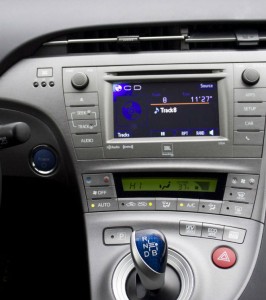 Further attempting to distinguish the Prius as something special is its “flying buttress” center console. Infotainment and controls are within easy reach. Prominent is the trademark joystick controller for Drive, Reverse, Neutral, and additional regenerative braking as well. Park is handled by a pushbutton next to the joystick. Under the center console is a convenient shelf.
Further attempting to distinguish the Prius as something special is its “flying buttress” center console. Infotainment and controls are within easy reach. Prominent is the trademark joystick controller for Drive, Reverse, Neutral, and additional regenerative braking as well. Park is handled by a pushbutton next to the joystick. Under the center console is a convenient shelf.
Function-wise, the Prius’ working environment is meant to simply work. It’s classified as mid-size by its interior volume, and the tall hatchback is sufficiently roomy for five adults.
Cargo hauling capacity is respectable with 21.4 cubic feet in the hatch. Fold flat the 60/40 split rear seats, and you open up 39.6 cubic feet. The hatch floor is flat, moderately high off the ground, but it’s relatively easy to slide things in and out with no outer lip blocking the way.
Varying levels of optional connectivity include Toyota’s Entune infotainment system and an Head Up Display (HUD). Entune is Brand T’s response to the Ford SYNC system and it pairs your smart phone via Bluetooth or a USB cable. The features are then operated using the vehicle’s controls or, for some services, by voice recognition. Mobile apps for Entune include Bing, iHeartRadio, MovieTickets.com, OpenTable, and Pandora. Entune data services include a fuel price guide, sports scores, stocks, traffic and weather.
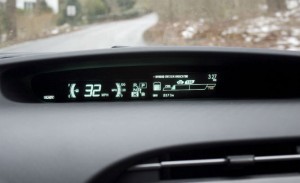 Safety wise, the car is government-rated with five-stars overall. Frontal crash protection is five stars for driver, four for passenger. Side impact protection nets five stars and rollover garners four stars. The LIftback comes with seven airbags, traction control for slippery conditions, and of course, ABS. Seatbelts also offer a “Pre-Collision System” that retracts them and applies the brakes right before an unavoidable impact. To help prevent you from getting to that point, the car also offers optional “Lane Keep Assist” using a radar system using advanced millimeter waves to keep you from veering off course. Also offered to prevent the ever-present allure toward distracted driving is “Touch Tracer” which shows on the prominent top-of-dash-mounted info display a virtual duplicate of the steering-wheel mounted infotainment controls. Additionally, intelligent parking helps guide the Prius into spaces, a backup monitor commandeers the infotainment screen when Reverse is engaged, and a voice-operated navigation system also helps keep eyes on the road.
Safety wise, the car is government-rated with five-stars overall. Frontal crash protection is five stars for driver, four for passenger. Side impact protection nets five stars and rollover garners four stars. The LIftback comes with seven airbags, traction control for slippery conditions, and of course, ABS. Seatbelts also offer a “Pre-Collision System” that retracts them and applies the brakes right before an unavoidable impact. To help prevent you from getting to that point, the car also offers optional “Lane Keep Assist” using a radar system using advanced millimeter waves to keep you from veering off course. Also offered to prevent the ever-present allure toward distracted driving is “Touch Tracer” which shows on the prominent top-of-dash-mounted info display a virtual duplicate of the steering-wheel mounted infotainment controls. Additionally, intelligent parking helps guide the Prius into spaces, a backup monitor commandeers the infotainment screen when Reverse is engaged, and a voice-operated navigation system also helps keep eyes on the road.
While no car is perfect, there’s a reason why the Prius has so many fans. For daily sensible driving, it does what a reliable car is supposed to do while delivering fuel economy that careful drivers regularly report as exceeding the EPA’s estimates.
That said, if one were to break the usual rules of fuel-efficient driving – with jackrabbit starts, greatly exceeding the speed limit, or simply driving it very hard – mileage will not meet EPA ratings.
The car is pretty tolerant of “normal” usage however and does not require infinite coddling.
As has been noted by many a reviewer, it’s not especially quick by sportier car standards, handles just-OK, and the electric steering rack feel has been criticized as nebulous as well. Overall, it’s no road scalpel, and does display a fair amount of body roll if pushed hard. Also, its braking is just decent – not bad, but not stellar either.
Working against the Prius as a performance machine is only modest power propelling a 3,042 pound curb weight, soft comfort-biased suspension and friction-reducing low rolling resistance tires. And by the way, these tires do transmit a fair amount of road noise into the cabin – along with a less-than musical exhaust note – and relatively modest sound deadening lets wind noise be heard somewhat plainly at highway speeds too.
And as for the comfortable suspension, it does a decent job, is definitely not harsh, but it’s not luxo-cush smooth either. These are compromises a prospective buyer must accept or pass on in deciding whether ultimate fuel efficiency is a big enough priority.
So, that’s the worst of it. All that said, it’s no hardship to operate the Prius and actually is pretty pleasant for getting around town or anywhere you need to go. The 2010 overhaul saw its 0-60 mph time whittled down to approximately 10 seconds. Is this dangerously slow? We do not think so, and once rolling this car will cruise at extra-legal speeds if you want, with a top speed north of 100 mph. It is definitely fast enough for the real world, and performs sufficiently for what people actually need.
Keep in mind also: Reviewers who pan the Prius as a frumpy just-OK ride are often enthusiasts who like the finer things in automotive life – such as ability to push the edge of lateral acceleration to near club-racer levels, or alternately, the experience offered by a plush, finely appointed car with more power also, adding to fashionable curb appeal.
It is into this mainstream world that the form-follows-function Prius has been thrust, and sure enough, it has had its share of detractors filtering things through their own criteria and biases.
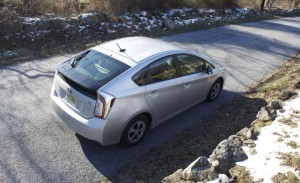 But truth be told, in normal situations, many drivers of high-performance cars do not push them to near their limits in daily driving. Often enough, you’ll see them plodding through traffic, and here’s the point: The Prius makes no effort to satisfy the spoiled, the jaded, or those who want super-legal speeds available on tap. Nope, the Prius is for utilitarian endeavors – and actually, it can be made to go at a brisk extra-legal clip with full control. It will never stay with a VW GTI on a racetrack, but it will keep up fine with a poser in a Porsche assuming he’s not driving his car near its potential.
But truth be told, in normal situations, many drivers of high-performance cars do not push them to near their limits in daily driving. Often enough, you’ll see them plodding through traffic, and here’s the point: The Prius makes no effort to satisfy the spoiled, the jaded, or those who want super-legal speeds available on tap. Nope, the Prius is for utilitarian endeavors – and actually, it can be made to go at a brisk extra-legal clip with full control. It will never stay with a VW GTI on a racetrack, but it will keep up fine with a poser in a Porsche assuming he’s not driving his car near its potential.
This is not to excuse the Prius for where it could be better, but just to put things into a more rounded perspective. We love driving fast too, but we see the Prius for what it is, and can understand why many people with gas-saving and environmental priorities never miss the 9/10s lateral acceleration or 0-60 times of more athletic cars.
Yen-to-dollar exchange rates and import costs for the Japanese-imported Prius notwithstanding, Toyota knows it has lost some perception battles, but is winning the publicity war and its price in part reflects this. Numbers do not lie, and the Liftback crushes all comers in the alternative energy market by a large margin. Baked in also is the hard-won “icon” status, and naturally, this is perceived as value added.
Tangible and intangible realities all told, the Prius Liftback ranges from $24,200-$30,005 before a $760 destination charge is added in. In October 2012 a sub-1-percent uptick of $200 per model was announced. This added to an average 3.2-percent price bump at the beginning of the 2012 model year.
As we speak, the market for high-efficiency cars is heating up as automakers anticipate federal and California mpg and emissions mandates along with those in Europe. Presently, there is no apple-to-apple Liftback competitor but – aside from its own Prius c and v siblings – there are alternatives worth considering depending on your proclivities.
These include the $27,200-$32,200 Ford Fusion Hybrid that’s EPA-rated at 47 mpg combined, city and highway – although at this writing, there is controversy as to whether this is optimistic or even false advertising. Another possibility – also undergoing the same scrutiny now – is the 47 mpg, $25,200-$28,200 Ford C-MAX Hybrid, although this quasi-wagon is more an alternative to the Prius v. Another possibility could be Toyota’s Camry Hybrid which is roomy, quicker, more conventionally styled, and costs within the realm at $25,900-$27,400. Its EPA rating is decent at 40 or 41 mpg combined for the XLE or LE respectively.
For less money, is the $18,600-$23,790 Honda Insight, but its 42 mpg combined from its the 1.3-liter hybrid electric powertrain is not even competitive with the second-generation Prius. It’s a better handling car though, but has less back seat space.
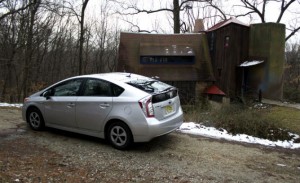 Alternately, you can consider spending more, but netting potential savings in the form of subsidies and lower operational costs to mitigate – or confuse – your choices. Included in this growing list is the plug-in Prius, the Ford C-MAX Energi, Fusion Energi, or Chevy Volt, among others. Federal tax credits are potentially available – $3,750 for the Toyota or Fords, $7,500 for the Chevy.
Alternately, you can consider spending more, but netting potential savings in the form of subsidies and lower operational costs to mitigate – or confuse – your choices. Included in this growing list is the plug-in Prius, the Ford C-MAX Energi, Fusion Energi, or Chevy Volt, among others. Federal tax credits are potentially available – $3,750 for the Toyota or Fords, $7,500 for the Chevy.
Crunching the numbers to determine whether plug-in cars make financial sense depends upon how many miles one actually drives per year, and actual electricity costs. Drivers doing somewhere over, say, 50-75 miles per day may pay less in total energy costs for the Prius depending on which plug-in is being compared, but you’ll want to carefully analyze your individual situation to be sure.
And, if after cross shopping you come back to the Liftback, it is the most proven of them all, and not likely a losing proposition. The car is now sold in at least 80 countries, has sold over 1 million units in the U.S. and 2.8 million globally.
It’s among the most conservative bets on an “alternative technology” there is, and maybe that’s why it remains by a large margin the sales king of them all.
About That Handling and Braking
The Prius is often rejected out of hand by those who decide it could potentially lower their testosterone levels – you know who you are.
This opinion – like those about everything else with the Prius – varies. But it’s a fact performance-oriented drivers – and even those just wanting something semi-sporty –often look askance at the car that makes a point of pride out of what others consider its lameness.
In stock form, the Liftback is currently as sporty looking as it ever has been, but the average Prius corners at around 0.68g, and stops from 60-0 in a not-great 138 feet.
This discussion does not need to end here, however. In June 2011, Toyota announced a dealer-installed PLUS Performance Package engineered by Toyota Racing Development (TRD). Toyota says the kit improves all handling weak spots (see video) with fewer tradeoffs than one might think. Namely, Toyota’s Product Specialist Moe Durand says mpg is not adversely affected because its uses a seven-piece wind-tunnel tested body kit that smoothes airflow under the car to mildly improve its already world-class coefficient of drag.
This trick of using the aero body kit compensates for higher rolling resistance but sticky low-profile tires on special 17-inch forged wheels – not cast wheels like on the Liftback Five and Persona Series. These stiffer, more expensive wheels are lighter and the sport tires’ extra grip and reduced unsprung weight is aided by high-carbon steel, powder-coated springs that drop the car 1.1 inches in front, 1.3 inches in back. This serves to lower center of gravity while stiffening the ride. To cap the package is a rear anti-sway bar, badging and logoed floor mats.
But be warned, tire life will be less than stock and the package will make ride comfort a degree more harsh – not as rigid as say a Mitsubishi Lancer EVO, but harsher than the stock Liftback. The tradeoff does net better handling however.
What does it all add up to? Toyota does not publish hard numbers, but the car looks and behaves sportier and braking distances are improved also from the grippier tires. The only other downside is you’ll be out somewhere between $2,999 if you do this upgrade for a Prius Five, and $3,499 for a Prius Two through Four. This is within range of the cost of upgrading to a next higher Prius trim level or two.
Further, now that you know TRD’s own formula, do you think the general aftermarket could do it for less? As a matter of fact, a quick Google search will show there is a healthy Prius performance aftermarket which Durand also noted. Lowering springs, a swaybar and wheels plus sport tires could also be done without the color-matched bodywork if you want to save on the total outlay, and odds are they will not void a new car warranty – but do check with your dealer first!
It also might cost you a mile or two per gallon if you forego the aero-improving body kit, we’re not exactly sure, but the Prius is already atop the mpg heap, so maybe the performance enhancements could be viewed as a worthwhile compromise?
This is just food for thought. If this road less traveled is within your risk tolerance and budget, you could take what others castigate as a prim and gelded car and surprise that unwary driver in the GTI – or Volt – on a twisty back road. Or it could make for simply more sporty looking, enjoyably handling car with dry conditions safety margin improved also from the better braking and control – snow belt drivers will want to switch out for winter or all-season tires as seasons dictate.
And of course sport driving can use more gas, but the rest of the time, you’d have fuel mileage as good as, well, a Prius. Or, if this sounds like nonsense and a stock Prius is all you need, that’s fine too. You’d certainly not be alone in that decision, as the Prius has more satisfied customers than any other hybrid to date.